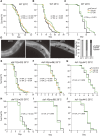No Significant Increase in the Δ4- and Δ7-Dafachronic Acid Concentration in the Long-Lived glp-1 Mutant, nor in the Mutants Defective in Dauer Formation
- PMID: 25971936
- PMCID: PMC4502381
- DOI: 10.1534/g3.115.018812
No Significant Increase in the Δ4- and Δ7-Dafachronic Acid Concentration in the Long-Lived glp-1 Mutant, nor in the Mutants Defective in Dauer Formation
Abstract
The steroid hormone dafachronic acid (DA) regulates dauer formation and lifespan in Caenorhabditis elegans by binding to the nuclear receptor DAF-12. However, little is known about how DA concentrations change under various physiologic conditions and about how DA/DAF-12 signaling interacts with other signaling pathways that also regulate dauer formation and lifespan. Using a sensitive bioanalytical method, we quantified the endogenous DA concentrations in a long-lived germline-less glp-1 mutant and in the Dauer formation-defective (Daf-d) mutants daf-12, daf-16, daf-5, and daf-3. We found that the DA concentration in the glp-1 mutant was similar to that in the wild type (WT). This result is contrary to the long-held belief that germline loss-induced longevity involves increased DA production and suggests instead that this type of longevity involves an enhanced response to DA. We also found evidence suggesting that increased DA sensitivity underlies lifespan extension triggered by exogenous DA. At the L2/L3 stage, the DA concentration in a daf-12 null mutant decreased to 22% of the WT level. This finding is consistent with the previously proposed positive feedback regulation between DAF-12 and DA production. Surprisingly, the DA concentrations in the daf-16, daf-5, and daf-3 mutants were only 19-34% of the WT level at the L2/L3 stage, slightly greater than those in the Dauer formation-constitutive (Daf-c) mutants at the pre-dauer stage (4-15% of the WT L2 control). Our experimental evidence suggested that the positive feedback between DA and DAF-12 was partially induced in the three Daf-d mutants.
Keywords: C. elegans dauer; daf-12; dafachronic acid; glp-1; steroid hormone.
Copyright © 2015 Li et al.
Figures



Similar articles
-
Dafachronic acid inhibits C. elegans germ cell proliferation in a DAF-12-dependent manner.Dev Biol. 2017 Dec 15;432(2):215-221. doi: 10.1016/j.ydbio.2017.10.014. Epub 2017 Oct 21. Dev Biol. 2017. PMID: 29066181 Free PMC article.
-
A bile acid-like steroid modulates Caenorhabditis elegans lifespan through nuclear receptor signaling.Proc Natl Acad Sci U S A. 2007 Mar 20;104(12):5014-9. doi: 10.1073/pnas.0700847104. Epub 2007 Mar 14. Proc Natl Acad Sci U S A. 2007. PMID: 17360327 Free PMC article.
-
The protein kinase MBK-1 contributes to lifespan extension in daf-2 mutant and germline-deficient Caenorhabditis elegans.Aging (Albany NY). 2017 May 25;9(5):1414-1432. doi: 10.18632/aging.101244. Aging (Albany NY). 2017. PMID: 28562327 Free PMC article.
-
Alternate metabolism during the dauer stage of the nematode Caenorhabditis elegans.Exp Gerontol. 2005 Nov;40(11):850-6. doi: 10.1016/j.exger.2005.09.006. Epub 2005 Oct 10. Exp Gerontol. 2005. PMID: 16221538 Review.
-
[Genetics and evolution of developmental plasticity in the nematode C. elegans: Environmental induction of the dauer stage].Biol Aujourdhui. 2020;214(1-2):45-53. doi: 10.1051/jbio/2020006. Epub 2020 Aug 10. Biol Aujourdhui. 2020. PMID: 32773029 Review. French.
Cited by
-
Larval crowding accelerates C. elegans development and reduces lifespan.PLoS Genet. 2017 Apr 10;13(4):e1006717. doi: 10.1371/journal.pgen.1006717. eCollection 2017 Apr. PLoS Genet. 2017. PMID: 28394895 Free PMC article.
-
Emerging topics in C. elegans aging research: Transcriptional regulation, stress response and epigenetics.Mech Ageing Dev. 2019 Jan;177:4-21. doi: 10.1016/j.mad.2018.08.001. Epub 2018 Aug 19. Mech Ageing Dev. 2019. PMID: 30134144 Free PMC article. Review.
-
Decoding lifespan secrets: the role of the gonad in Caenorhabditis elegans aging.Front Aging. 2024 Mar 26;5:1380016. doi: 10.3389/fragi.2024.1380016. eCollection 2024. Front Aging. 2024. PMID: 38605866 Free PMC article. Review.
-
The Role of Dafachronic Acid Signaling in Development and Longevity in Caenorhabditis elegans: Digging Deeper Using Cutting-Edge Analytical Chemistry.Front Endocrinol (Lausanne). 2016 Feb 11;7:12. doi: 10.3389/fendo.2016.00012. eCollection 2016. Front Endocrinol (Lausanne). 2016. PMID: 26903948 Free PMC article. Review.
References
-
- Antebi A., 2013. Steroid regulation of C. elegans diapause, developmental timing, and longevity. Curr. Top. Dev. Biol. 105: 181–212. - PubMed
-
- Arantes-Oliveira N., Apfeld J., Dillin A., Kenyon C., 2002. Regulation of life-span by germ-line stem cells in Caenorhabditis elegans. Science 295: 502–505. - PubMed
-
- Berman J. R., Kenyon C., 2006. Germ-cell loss extends C. elegans life span through regulation of DAF-16 by kri-1 and lipophilic-hormone signaling. Cell 124: 1055–1068. - PubMed
-
- Cassada R. C., Russell R. L., 1975. The dauerlarva, a post-embryonic developmental variant of the nematode Caenorhabditis elegans. Dev. Biol. 46: 326–342. - PubMed
Publication types
MeSH terms
Substances
Grants and funding
LinkOut - more resources
Full Text Sources
Other Literature Sources
Miscellaneous
